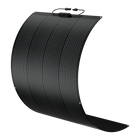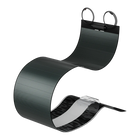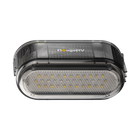How To Charge The Marine Battery With Solar Panel?


Do you want to switch to a more environmentally-friendly and sustainable energy source on your boat? Well, you're in luck because, in this article, we will show you how to charge your marine battery with solar panels.
But before we dip into the nitty-gritty details, we are happy to tell you that at BougeRV, provide high-quality solar panels well-designed for marine batteries and can withstand even the harshest of environments. Plus, we offer top-notch customer service and competitive prices.
Back to the topic. Solar panels can easily charge your marine battery and reduce your carbon impact. Let's get started to take a look at what size solar panels to choose for a boat, and the steps to charge the marine battery using solar panels. Discover now!
Will A Solar Panel Charge A Marine Battery?

Solar power is becoming increasingly popular as an energy source due to its environmental benefits and long-term cost savings. But will a solar panel actually charge a marine battery?
The brief answer is yes, a solar panel can charge a marine battery. It's an efficient and reliable way to keep your battery charged while out on the water. However, there are a few things to recall before making the switch to solar power.
Firstly, you'll need to choose the right solar panel for your needs. Marine solar panels come in different wattage ratings and sizes, so choosing one that will provide enough power to charge your battery is important. You'll also need to consider the size of your boat and the available space for the solar panel.
Once you've chosen the right solar panel, you'll need to install it correctly. Mounting the panel in a location that receives maximum sunlight, such as on the top of your boat's cabin, but more is needed, let's discuss more of them in detail in the sections below.
What Size Solar Panel To Charge The Marine Battery?
On an average sunny day, a typical 100W solar panel can create about 30Ah a day. Given that your boat is powered by a 12V deep cycle marine battery, 3 BougeRV Yuma 100W CIGS solar panels or a single 300W solar panel is sufficient to charge it. But remember that 12V batteries have different capacities varying from 5-200Ah.
BougeRV Yuma 100W and 200W CIGS Thin-film Flexible Solar Panels are top-of-the-line marine solar panels that are designed specifically for the harsh marine environment. Made from CIGS thin-film technology, they are flexible and perfectly conform to the curves and contours of your boat.
They’re also lightweight and easy to install, making them great choices for boaters who want to add solar power to their setup.
With a wattage rating of up to 200 watts, BougeRV’s Yuma CIGS solar panel for boats can generate enough power to charge even larger batteries quickly and efficiently. Featuring IP68 waterproof ratings and durable designs, they’re also built to withstand the rough marine environment.
But how do you use this outstanding product to charge your marine battery or, in general? Let's take a look at it step by step.
How To Charge The Marine Battery With A Solar Panel?

1. Choose The Right Solar Panel
Before you can start charging your marine battery, you need to ensure you have the right solar panel and solar panels in the right size. Choosing a solar panel specifically designed for marine use, such as the Yuma 100W and Yuma 200W CIGS Thin-film Flexible Solar Panel, is essential.
This type of solar panel is perfect for boats because it is thin, flexible, and lightweight, making it easy to install and move around. It also performs well on cloudy days or when it’s shaded by boat canvas. With the Yuma solar panel, you can enjoy a reliable and efficient way to charge your marine battery.
2. Prepare Essential Components To Charge A Marine Battery With A Solar Panel
Once you have the right solar panel, you must gather some essential components to complete the charging process. These components include a charge controller, a battery monitor, and the necessary wiring.
The charge controller is necessary to regulate the voltage and current that flows from the solar panel to the battery. With its intelligent management capabilities, it optimizes the charging process, maximizing energy production, protecting batteries from overcharging, extending their lifespan, and ensuring a reliable and efficient power supply.
The battery monitor helps you keep track of the battery's charge level so you know when it's time to recharge. And the wiring is what connects everything together, ensuring a smooth flow of energy.
3. Hook Up Your Solar Panel To Marine Boat Battery

Now that you have all the necessary components, it's time to connect the solar panel to your marine battery. Start by placing the solar panel in a location with plenty of sunlight, ideally on the boat's roof or deck.
4. Clean the Terminals
Before connecting any cables, it's important to clean the terminals of your marine battery. Over time, the terminals can become corroded, which can impede the flow of electricity. To clean the terminals, use a wire brush or sandpaper to remove any rust or debris. Once the terminals are clean, you can proceed with the next step.
5. Connect the Cables
To connect the battery and solar panel, you'll need cables with connectors matching the terminals on your battery. The red cable should be connected to the positive terminal, and the black cable should be connected to the negative terminal. Check that the connections are snug and secure.
6. Connect the Charge Regulator
A charge regulator is an essential component when it comes to charging a marine battery with a solar panel. It regulates the flow of electricity and prevents overcharging, which can damage the battery. Connect the charge regulator to the battery, making sure to follow the manufacturer's instructions.
7. Connect The Charge Controller To The Marine Solar Panel

The last step is to connect the solar panel to the charge controller. The charge controller regulates the flow of electricity from the solar panel to the battery. Connect the solar panel's positive and negative cables to the positive and negative inputs on the charge controller. Again, make sure the connections are tight and secure.
8. Connect The Marine Battery To The Charge Controller
Now that the charge controller and solar panel are connected, it's time to connect the marine battery to the charge controller. To do this, locate the battery terminals and connect the positive cable to the positive terminal and the negative cable to the negative terminal. Check that the connections are tight and secure.
9. Check The Indicator
Most charge controllers have an indicator that shows the battery's charging status. It is essential to monitor this indicator to ensure the battery is charging correctly. If the indicator shows that the battery is not charging, check the connections and ensure the solar panel receives enough sunlight.
10. Monitor The Charging
It's essential to monitor the battery's charging level regularly, especially if you plan to use it for an extended period. You can use a battery monitor to check the charging level. If the battery is not charging as expected, check the connections and ensure the solar panel receives enough sunlight.
How To Disconnect Your Marine Battery
When you're done charging your marine battery with a solar panel, it's crucial to disconnect it correctly. Start by disconnecting the negative cable from the battery terminal, followed by the positive cable. Ensure that the cables are not touching each other or any other metal objects. Keep the batteries in a cool, dry area out of direct sunlight.
Conclusion

Till now, you’ve known the steps for charging the marine battery with sila panels. Now, charge your marine battery with a solar panel to save money on electricity costs and reduce your carbon footprint.
By following these steps and using a high-quality marine solar panel like the Yuma 100W and 200W CIGS Thin-film Flexible Solar Panel, you can enjoy a reliable and cost-effective energy source for your boat!
FAQs
1. Can I Stand On Marine Solar Panels?
No, it is not recommended to stand on marine solar panels. Walking or standing on the panels can damage them and reduce their efficiency.
However, accidentally stepping on BougeRV’s Yuma CiGS solar panels doesn't damage them and they can still function. The thin-film flexible solar panel are glass-free and are highly durable withstanding any impacts that may occur during installation.
2. How Long Will A 200-Watt Solar Panel Take To Charge A 12V Battery?
The time it takes to charge a 12V battery with a 200-watt solar panel depends on several factors, such as the battery's capacity, the quantity of sunlight available, and the efficiency of the charging system.
As a general guideline, a 200-watt solar panel can charge a 12V battery in approximately 5-6 hours of direct sunlight.
3. How Fast Will A 100w Solar Panel Charge A 12V Battery?
The charging speed of a 100W solar panel to a 12V battery depends on several factors, such as the battery's capacity, the amount of sunlight available, and the efficiency of the charging system. Typically, a 100W solar panel can charge a 12V battery in about 6-9 hours of direct sunlight.
4. What Happens When A Battery Is Fully Charged By A Solar Panel?
When a solar panel fully charges a battery, the charging system should automatically stop charging the battery to prevent overcharging, which can damage the battery.
If the charging system does not automatically stop charging the battery, it is recommended to disconnect the battery from the solar panel to prevent overcharging.
5. Can You Charge A Deep-Cycle Marine Battery With A Solar Panel?
Yes, you can charge a deep-cycle marine battery with a solar panel. Deep-cycle marine batteries are commonly used for marine applications and are designed to be charged and discharged multiple times.
6. Can I Charge A Battery Directly From A Solar Panel?
Yes, charging a battery straight from a solar panel is possible, although this is not recommended. Directly connecting a battery to a solar panel can lead to overcharging, which can damage the battery.
Using a charge controller between the solar panel and the battery is recommended to regulate the charging process and prevent overcharging.







































